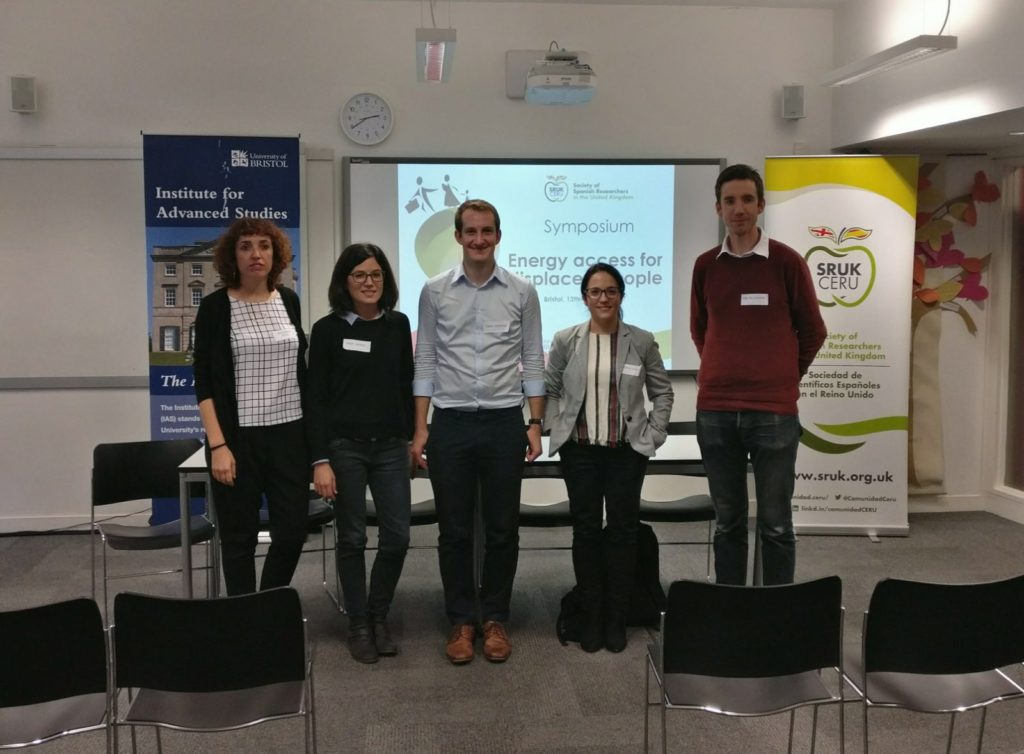“About 80% of refugees in temporary settlements have access to just basic energy resources, like few logs and coal.”
- The Society of Spanish Reseachers in the United Kingdom (SRUK/CERU) holds a symposium to discuss the energy challenges of temporary settlements.
- Environmental and energy sustainability, key to the energy challenges faced by the temporarily displaced population.

Speakers (from left to right): Alejandra Rojo, Irene Merino Jimenez, Owen Grafham, Monica Garcia Ortega, Sam Williamson (chair)
Bristol, UK, October 12th, 2017. The Society of Spanish Researchers in the United Kingdom in collaboration with the Cabot Institute and the Institute for Advanced Studies at the University of Bristol has hosted the symposium “Energy Access in Displaced Populations” in the city of Bristol. This event, funded by the Ramón Areces Foundation, has brought together experts in the energy challenges facing displaced populations where sustainable solutions have been discussed.
Electrical energy is crucial in the development of modern society. One of the challenges of the 20th century has been its generation and the universalization of access to it. However, not all populations have the possibility of using electricity. This problem is especially relevant for the displaced populations, estimated at about 60 million people, forced to live in temporary settlements where infrastructure and energy alternatives are limited. Research groups around the world are currently seeking solutions to the problem of energy supply in these situations, the progress of which has been discussed today in Bristol.
Owen Grafham (Chatham House, London) co-authored the book entitled “Heat, Light and Energy for Refugees: Saving Lives, Reducing Costs”, stressed that because of the inefficient management of energy resources “about 20,000 displaced people die prematurely every year as a result of cooking with wood fires”. In addition, Owen has pointed out the importance of improving energy production sustainably in these temporary settlements to achieve an improvement in the quality of life, since “a refugee will spend an average of 17 years there. This is not a short-term problem. ”
Dr Mónica García (International Energy Agency, Greenhouse Gas R & D Program, IEAGHG) and technology analyst of the carbon capture team, where she participates in technical studies, has focused her talk on CO2 emissions and the emerging technologies such as novel CO2 capture solvents to storage carbon in order to keep Paris Agreement’s central aim: keeping a global temperature rise this century well below 2 degrees Celsius.
As an example of the most recent actions, Alejandra Rojo Losada (Center for Innovation in Technology for Human Development, Universidad Politécnica de Madrid, Madrid) has presented the project carried out in Northern Ethiopia by Shire Alliance, where thanks to coordination between public administration, business and university, have made progress in solving a complex problem in humanitarian action: access to energy in refugee camps. “In addition to working with such different actors, refugee participation has played a key role, from training to the installation of equipment “, says Alejandra Rojo. Public lighting has now been installed in more than 4r kilometres and connected services such as a primary school, 2 communal kitchens and 36 small businesses.
Finally, Dr. Irene Merino Jiménez (Bristol Bioenergy Center, UK and CSIC National Center for Microelectronics, Barcelona, Spain) has explained the benefits of the development of microbial fuel cells, a highly innovative technological system. These devices, which are also very affordable, are based on the use of organic waste (such as urine) to generate energy. This technology generates electrical energy directly through the decomposition of organic matter through the metabolism of microbes previously introduced into the system. Thus, in addition to producing electricity, the demand of chemical oxygen is reduced thus treating the urine without the need for a waste water treatment plant. In addition, during the process it is possible to recover the nutrients contained in the urine, including struvite, which can be used as fertilizer, or the so-called catholyte, whose use as a disinfectant is being investigated.
At the end of the symposium, Sam Williamson (Faculty of Engineering, University of Bristol, UK) has moderated a round-table discussion in order to share ideas about energy supply and refugee needs, highlighting the requirement to involve governments in improving the long-term sustainable energy access of displaced populations.



